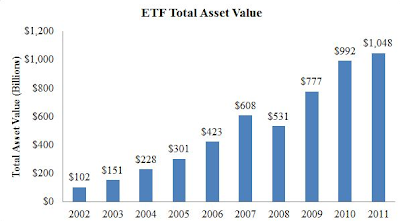WSJ on Innovation in Commodity ETFs
(Mar 2012)
Yesterday the Wall Street Journal ran an article about recent innovation in the commodity ETF space. Our work on commodity ETFs has focused on their use of constant-maturity rolling futures strategies, which incur a roll yield depending on conditions in the futures markets. Now, according to the WSJ, many ETF issuers are choosing more complex strategies to try to mitigate these and other effects in commodities markets:
Some of these new products use complex formulas to identify commodities...
Time to Call for More Transparency in ETF Market
(Mar 2012)
Exchange-traded funds (ETFs) started as a "plain vanilla" product: a type of low-fee, tax-efficient mutual funds holding index-mimicking portfolios. The first ETF was formed by the Toronto Stock Exchange in the 1980s and has garnered spectacular popularity in recent years. According to a recent article in The Economist, the number of ETFs in America has almost tripled from its 2006 level of 343 to 1,098 in December 2011. This volume increase has been accompanied by substantial financial...
Mutual Fund Expense Analyzer: A Tool for Calculating Mutual Fund Fees and Expenses
(Feb 2012)
Every mutual fund investor should know how important fees and expenses are in determining the net return of his investment. Compared with other factors affecting a mutual fund's or an Exchange Traded Fund (ETF)'s return, such as market returns, fees and expenses are more stable over time and it is therefore easier to predict their effect on a fund's future performance. However, comparing fees and expenses across funds can be tedious and confusing, as different funds can use different fee...
ETFs' Asset Value is Increasing, Trading Volume Remains Stable
(Feb 2012)
Financial Times reports that the daily trading volume in the 50 most traded US ETFs in this January and last December was at its historical lows, dropping to the level of the end of 2007. This is surprising since over the past decade the total asset value of ETFs have increased from its 2002 level of $102 billion to just over $1 trillion in 2011 according to the Investment Company Institute. Below we plot the ETF total asset value over the last decade.
Intuitively, one would expect as asset...
Reserve your Clever ETF Ticker Before it's Too Late
(Feb 2012)
The Wall Street Journal reported yesterday that descriptive and catchy tickers for Exchange Traded Funds (ETFs) are getting harder and harder to come by these days. From the article:
But finding a catchy symbol can be tough these days. Many have already been taken: 1,350 symbols are in use on the NYSE Arca alone, the biggest U.S. market for exchange-traded products. That's up 108% over the past five years, says Ms. Morrison. In addition, fund firms have reserved 2,446 symbols for future...
President and CIO of Direxion admits that leveraged ETFs are not appropriate for most investors
(Jan 2012)
Today Seeking Alpha posted an interview with Dan O'Neill, President and CIO of Direxion, one of the first and best known issuers of leveraged ETFs. Readers familiar with our work on leveraged ETFs know that we feel these products are almost always unsuitable for retail investors.
Surprisingly enough, Mr. O'Neill agrees completely:
The leveraged indexed ETFs are used by very tactical investors, and so there we have bull and bear funds. They have daily betas, which means that essentially...
FINRA Regulatory Notice: Complex Products
(Jan 2012)
FINRA recently released Regulatory Notice 12-03: Heightened Supervision of Complex Products, outlining their increased scrutiny of a wide variety of alternative investments including structured products, inverse or leveraged exchange traded funds, and asset-backed securities. Here at SLCG, we've done research on each of those subjects, and have a variety of ongoing projects that bear directly on the issues highlighted by the Notice.
The products identified include:
Futures-Based (Commodities) ETFs
(Jan 2012)
Investors may think, when investing in Futures-Based Commodities exchange traded funds (ETFs), that they are gaining exposure to the underlying commodity. In this blog post, we discuss the ability of these ETFs to track the spot price of the underlying commodity.
In a previous blog post, we introduced the basics of Exchange Traded Funds (ETFs). In this post, we are going to discuss a specific kind of ETF: Commodities Futures Based ETFs.
There are a large number of Exchange Traded Funds...

